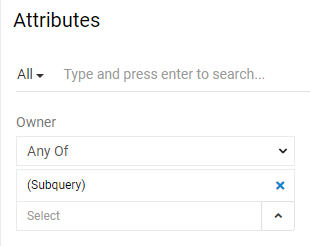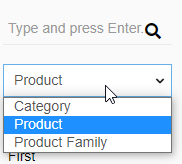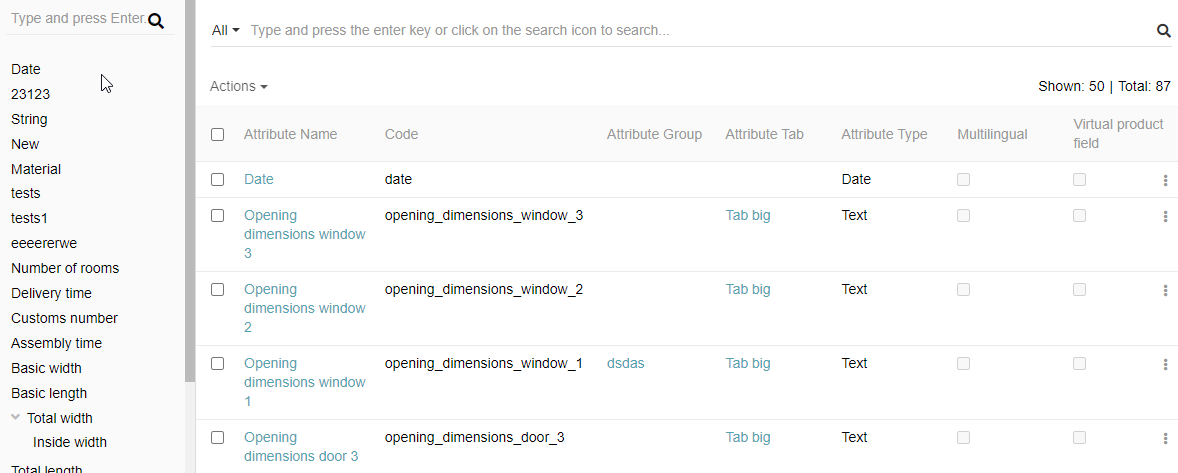AtroCore provides Search and Filtering to locate and limit records displayed in entity list views. Search is used to find records within the currently opened entity based on matching field values, while filtering works also on the related records, which are configured by the administrator.
Use the global search if you wish to search globally across all the entities in the system.
The filters in AtroCore let you control which records are displayed. There are three types:
- General filters – prebuilt on/off filters available for every entity by default, such as Active or Deleted
- Saved filters – advanced filters that were saved and can be reused, with visibility set to private or public
- Advanced filter – a flexible tool for creating complex filters for entities by combining multiple rules and conditions, allowing precise control over which records are included
Search
Search allows quick access to records by entering text that matches field values. These sections are automatically available on each entity list view page:

To perform a search operation, enter the search query into the search field and press Enter or click the Search button (magnifying glass). To reset search, click the Search reset button.
The search function looks through the record identifiers, text fields (string, text, email, URL, HTML), and numeric fields (integer, float). Search is case-insensitive.
A match in any searched field returns the record. If no matches are found, an empty result is displayed. Search can be used alone or combined with filters for more precise results.
Search Behavior
Search behavior depends on query length and field type:
For numeric fields:
Numeric fields require the full value to be entered in a valid format. In the case of Float values, the format must include the appropriate decimal separator.
For queries shorter than 4 characters:
- Text fields match values that start with the entered text
- Example: "pos" finds "position" but not "outpost"
For queries 4 characters or longer:
- Text fields match values that contain the entered text anywhere
- Example: "post" finds both "position" and "outpost"
String fields have different filtering behavior compared to other text fields. By default, string fields do not use the contains operator when filtering.
This behavior can be modified for text fields through the Use 'contains' operator when filtering varchar fields setting in System Settings. When enabled, String fields use "contains" matching for queries 4 characters or longer, similar to text fields.
Wildcards
Wildcards can be used at any place in the search string, separately or in combination:
| Character | Use |
|---|---|
| % or * | Matches any number of characters, including zero |
| _ | Matches only one character |
The search is performed strictly according to the specified pattern, rather than using the default behavior. The entered value is interpreted as a search pattern, not as a literal string.
Examples:
- "*smith" finds values ending with "smith"
- "test*" finds values starting with "test"
- "test" finds values containing "test"
Search Limitations
Direct text search does not operate on values stored in Reference-type fields, as these fields contain references to related records rather than plain text data. Such fields, including those configured as lists or links, are not searchable via the standard search input.
However, Reference-type fields can be used in Advanced Filters, where filtering is performed based on referenced entities and their attributes.
General and Saved filters
General filters are default boolean filters available for each entity (e.g., Active, Deleted, Bookmarked).
Saved filters are advanced filter configurations that have been saved for reuse. They can be marked as Public or Private and function as prebuilt on/off filters.
Both General and Saved filters are displayed in the header panel next to the Search bar and in the right sidebar under the Filters section.
To apply a filter, check the corresponding box in either panel. Changes are applied immediately. When multiple filters are active, they work with AND logic—records must match all selected filter conditions to be displayed.
To reset filters, use the Reset Filter button in the Header Bar or click Unset All in the right sidebar. To remove a specific filter, uncheck its box.
Search and filters are independent mechanisms. Clearing the search does not affect active filters, and resetting filters does not clear the search field. Both must be cleared separately to return to default view.
Filters can be used together with Search or Advanced Filter, or on their own. If no records match the applied criteria, an empty result is displayed.

Advanced Filter
The Advanced Filter is available in the list view for all Basic, Archive and Hierarchical entities.
Advanced Filter enables finding specific records by applying rules to fields or attributes of an entity. Multiple rules can be added, combined using "AND" or "OR" operators, grouped together for complex queries, and saved for future use.
Filter settings are stored in local storage. This means that the filter remains active even when switching between entities, until it's manually disabled.
Advanced filter configuration
To filter records by certain fields or attributes, click the Add Rule button in the "Advanced Filter" section of the right sidebar. A window for selecting a rule for the field or attribute appears. Additional rules can be added by clicking the button again.

Click inside the Select Field/Attribute field and select from the drop-down list or start typing the name of the desired field. If the entity has attributes, the "Attributes" section will exist in the drop-down list. Click [Add Attribute] and select one of the entity's attributes to create a rule for it.
Several rules can be combined with the "AND" or "OR" operators. Groups of rules can also be added and combined with other rules or groups.

The filter in the example above consists of two groups joined by the "OR" operator. It finds all Products from the Electronics Category whose EAN number contains "38" or products from the Footwear Category whose EAN number contains "39".
Once configured, click Apply. The toggle next to "Advanced Filter" indicates if the filter is active. The filter can be disabled using this toggle—the configuration will remain saved in local storage. Click Clear to remove all rules.
How to save a filter
Configured filters can be saved as Private (for individual use) or Public (for all system users). To save a filter, create it in the Advanced Filter panel by adding one or more rules, apply it, and click the Save button.

In the modal window, set the name of the filter and whether it should be public.

Saved filters appear in the Filters panel for the entity. Available actions include:
- Edit – Modify the filter rules
- Copy – Duplicate the configuration into the Advanced Filter panel for further editing
- Rename – Change the name or visibility of the filter
- Delete – Remove the filter

Available Filtering Criteria
Depending on the field/attribute type, the following filtering criteria can be applied:
| Field Type | Filtering Criteria | Input Value |
|---|---|---|
| Array, List, Multi-value list, Static List, Static Multi-value List, Link, Link Multiple | In/Not In | Value list, multiselect |
| Is Empty/Is Not Empty | – | |
| Boolean | – | Checkbox |
| Integer, Float | Is Not Empty | – |
| Is Null/Is Not Null | – | |
| Equals | Input field | |
| Not Equals | Input field | |
| Greater | Input field | |
| Less | Input field | |
| Greater or Equals | Input field | |
| Less or Equals | Input field | |
| Between | 2 Input fields | |
| Date, DateTime | Is Null/Is Not Null | – |
| Current Month | – | |
| Last Month | – | |
| Next Month | – | |
| Current Year | – | |
| Last Year | – | |
| Last X Days | Input field | |
| Next X Days | Input field | |
| Less | Date picker | |
| Less or equal | Date picker | |
| Greater | Date picker | |
| Greater or equal | Date picker | |
| After X Days | Input field | |
| Equal | Date picker | |
| Not Equal | Date picker | |
| Between | 2 Input fields | |
| String, Text, URL, HTML | Contains | Input field |
| Equals | Input field | |
| Not Contains | Input field | |
| Not Equals | Input field | |
| Is Empty | – | |
| Is Not Empty | – | |
| User-type fields (Assigned user) | In | User picker |
| not in | User picker | |
| is me | - | |
| is not me | - | |
| is member of my teams | – | |
| Is Empty | – | |
| Is Not Empty | – | |
| include me | – | |
| exclude me | – | |
| is my team | – | |
| is not my team | – |
Subfilters
Additional sub-filters can be added when creating filters. For example, to filter products by specific Files (main filter) and limit those files to a certain type—such as only Image Files—a sub-filter within the main filter is needed. This sub-filter refines the main filter criteria to include only the desired file types.
To create such a filter:
- Add a rule for Files with the criteria set to "In", then click
Selectto open a modal window for selecting files - Filter data in the popup window according to the needed criteria and apply the filter inside the modal window
- Check all filtered records using the
Select Allcheckbox and clickSelect

The modal window will close and the main filter will be shown as below:

This approach is more accurate than manually selecting individual results because it is faster, especially with large result sets, and automatically updates when the database changes—no manual filter updates are needed.
When using
select all resultsoption, all additional data that fit the filters will be automatically added if the filtering is reused.
Left Sidebar Search
For all entities there is an additional panel where records can be searched and filtered by Link or Link Multiple fields. For example, for the Product entity, these can be Categories, Brands, Classifications, Catalogs, etc.

The entity can be viewed by its hierarchy, as a tree. Press arrows to proceed down by hierarchy and Show more to see more records. Selecting a record opens the details menu. In the details menu, the hierarchy panel shows the path to the record. If viewing by category, for example, it will show the category the product is in. If there is no such category, it will show the general tree.

If the same entity is selected in the left panel as the page being viewed, the "Apply main search and filter" toggle appears below the search. It is enabled by default. Disabling the toggle prevents the main filter and search from applying to the record list in the left sidebar. If the toggle is enabled, the text search in the left sidebar will be applied in addition to the main filter.

In addition to relative fields, there is a Bookmarks link at the top of the left sidebar.
Bookmarked records can be filtered by any filter and searched both in the left sidebar and on the main page.
Automatic Search Mask Recognition (in development)
AtroCore has automatic search mask recognition. This can be considered as a quick search function—when typing begins, the system automatically determines the search mask type of the search string. Automatic search mask recognition is available for the following field types: Text, Number, Date, and Time.
Depending on the search mask type, the system searches through all entity fields of the appropriate field type. A pop-up with auto-suggestions appears with information about field name and amount of search results for that field, e.g., "Address: 3 results", and text links to show the results.
If nothing is chosen from the auto-suggesting pop-up, clicking the magnifier icon performs normal search (only through the fields listed in the metadata for this entity).
After clicking on the search results, the appropriate filter will be set automatically and the search field will be left empty.
| Search Mask Type | Field Types to Be Searched | Applied Filter Criteria |
|---|---|---|
| Text, e.g. "atro 123" | Address, Number, Varchar, Text, URL, Wysiwyg | Starts with |
| %Text, e.g. "%atro 123" | Address, Number, Varchar, Text, URL, Wysiwyg | Consists |
| Numbers, e.g. "123" | Address, Number, Varchar, Text, URL, Wysiwyg | Starts with |
| Numbers, e.g. "123" | Auto-increment, Currency, Integer, Float | Is |
| Date, e.g. "12.12.2018" | Date, DateTime | On |